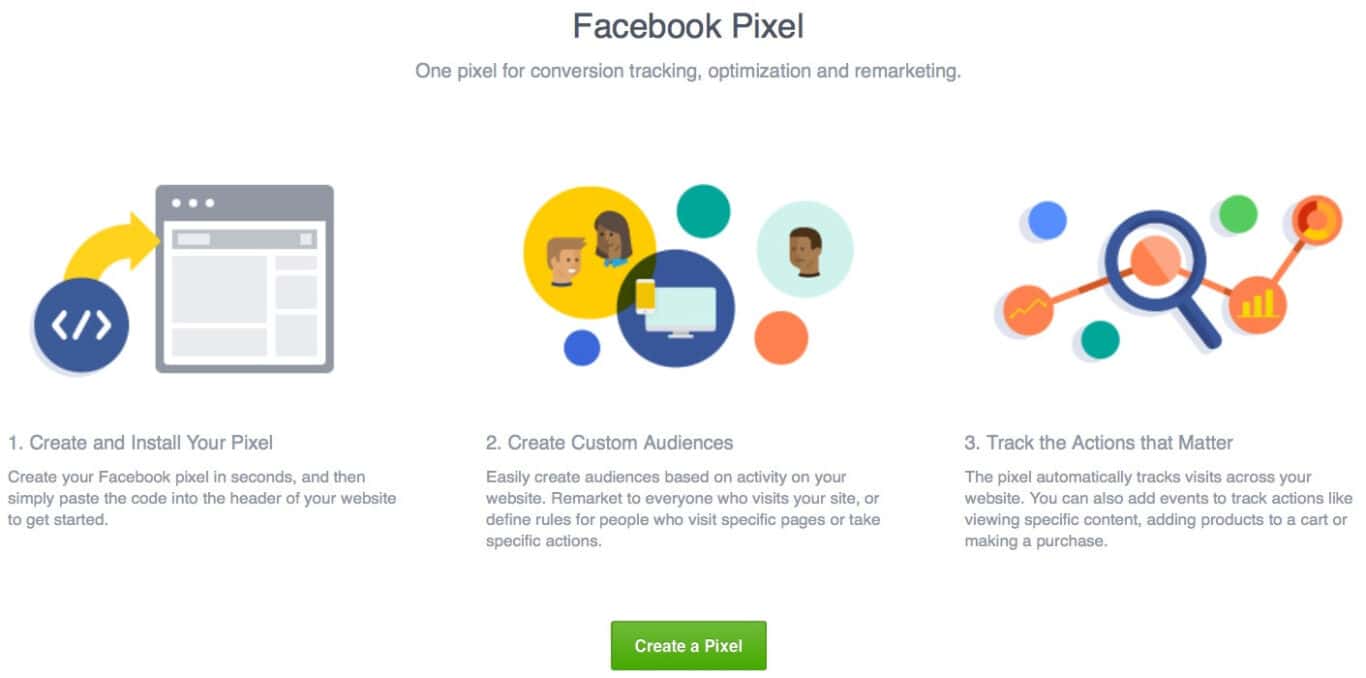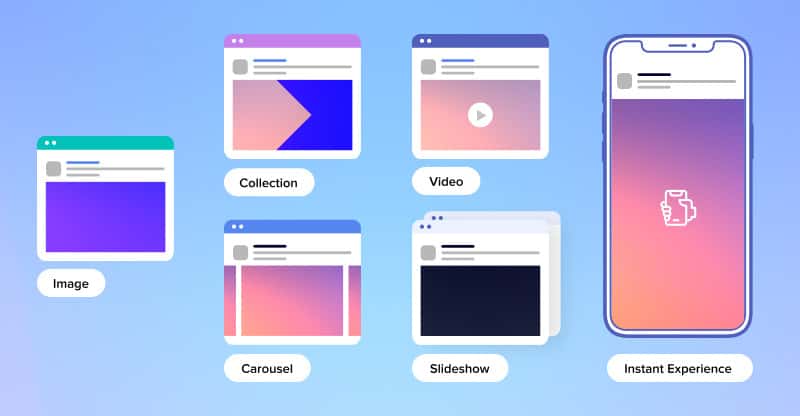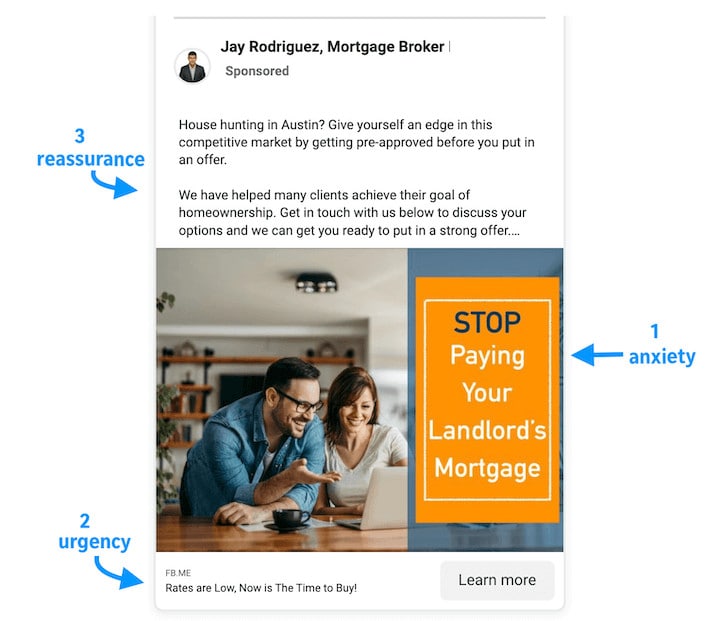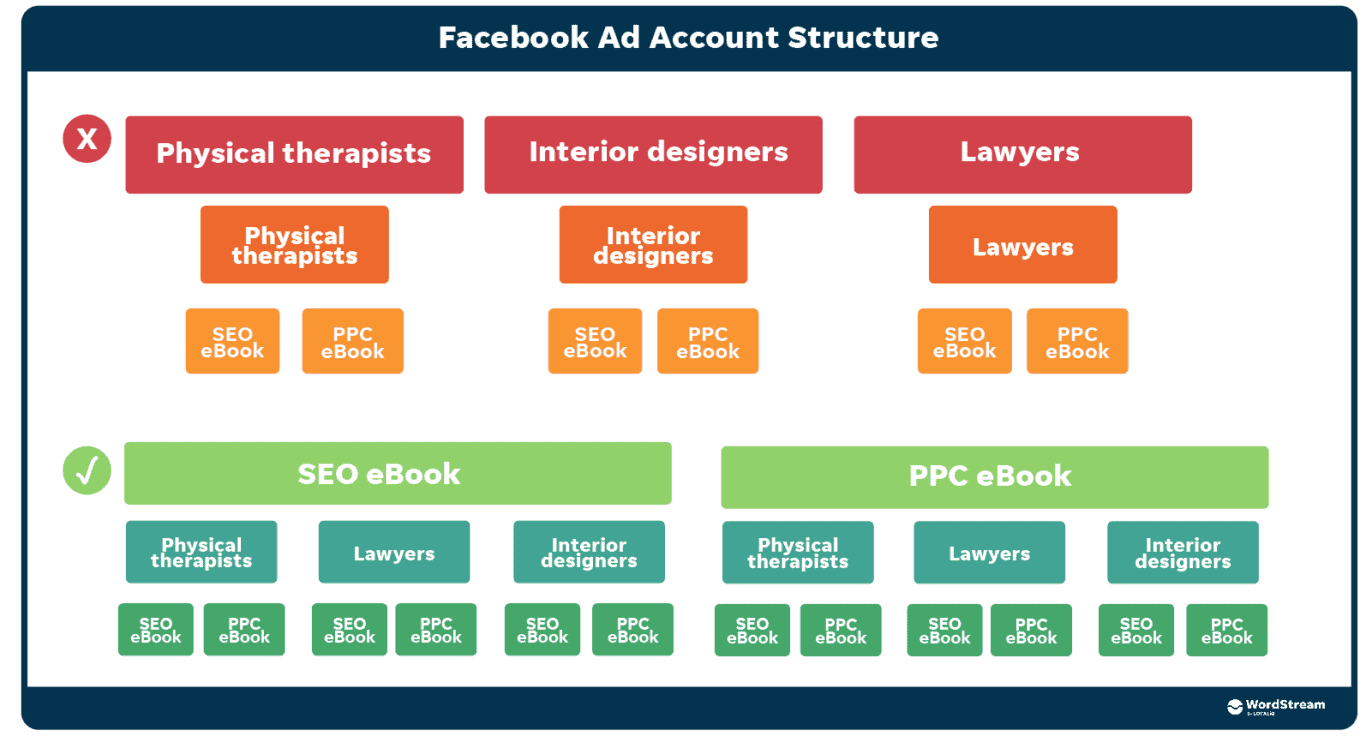Maximize ROI: Essential Facebook Advertising Strategies to Deploy in 2025
Nearly 20 years after its founding, and boasting over 2.91 billion active accounts globally, Facebook still hosts a massive audience across categories just waiting to be tapped into. Those numbers, of course, exclude Instagram, another Meta-owned company you might have heard of. Equipping your marketing team with the right Facebook ads strategy through mobile ads, paid campaigns, careful ad placement, thoughtful ad creatives can lead to untold success in your social media advertising efforts.
But running Facebook ad strategies for a custom audience in the right ad formats with a team that can create compelling ad copy for dynamic product ads is no easy feat. For newcomers to Facebook ad types, learning what makes for great Facebook ads, it’s important to set the right goals for yourself and continually revise and iterate your Facebook strategy.
Below we’ll take you through the ins and outs of Facebook ad strategies, so you can learn to put together the ideal business Facebook post, run a Facebook campaign effectively, and target new customers for your sales funnel.

In this article:
- Understanding Goals, Strategy, and Tactics
- What are the typical goals of a Facebook advertising strategy?
- Figuring out your target audience
- Analyzing Audience Behavior
- Experiment with Facebook Pixel
- Ad formats for Facebook users
- Craft Compelling Ad Copy
- Optimizing Facebook ad strategy
- Combining organic and paid strategies
- Geo-targeting for maximum impact
- Syncing Facebook Ads with Google Sheets Using Unito
- Summary and Key Takeaways
First Things First: Set Your Facebook Ad Goals, Strategy, and Tactics
Before you jump into your ad account on the Facebook platform to set up targeted ads, it’s essential to establish clear and measurable objectives for your ad strategy before you implement any tactics. What’s the difference?
Goals
These are the specific, measurable marketing objectives that your CMO or VP Marketing wants you to achieve. They are the “what” in your plan: quantifiable milestones that provide focus and direction. Goals should be SMART: Specific, Measurable, Achievable, Relevant, and Time-bound.
For example, boost brand awareness by 25% among Facebook users within one year’s time or increase lead generation from Facebook by 30% in six months.
Strategy
This is your master plan, the overarching approach you take to achieve your goals. Your advertising strategy needs to be rooted in a deep understanding of your market, competition, and unique value proposition.
Following our example goal above, a strategy here could be to look for Facebook groups or communities common to a particular audience from a specific market that your team believes is likely to convert.
Tactics
Tactics are the specific actions, tools, and techniques you employ to execute your strategy and reach your goals. They are the “do” in your plan, the practical steps that must be taken.
As the last step in our example, this could be a plan to create ads that target people with a demonstrated interest in your products but not purchased them before, or to focus ad creative on a particular Facebook ad that matches the campaign objective across: Facebook stories ads, Facebook Messenger, Facebook marketplace, etc.

Understanding and clearly differentiating between goals, strategy, and tactics will allow your marketing team to build momentum with their Facebook ad strategies. You’ll then be able to target users from a custom audience much more effectively through your Facebook ad account.
What are the typical goals of a Facebook advertising strategy?
The most common Facebook ad objectives typically fall into one or more of these categories:
Website Traffic: Bring more visitors to your website to increase brand awareness, generate leads, or promote specific products or services.
Lead Generation: Gather contact information from potential customers to nurture relationships and move them further down the sales funnel.
Conversions: Encourage specific actions, such as online purchases, product trials, or downloads, to measure the effectiveness of your ads.
Brand Awareness: Increase brand recognition and establish a positive brand perception among your target audience.
*Pro tip – Facebook will suggest a Call to Action (which we’ll get into below) based on your advertising goals.

By clearly defining advertising objectives, you can tailor campaign strategies, ad formats, and creative elements to achieve the desired outcomes. Doing so early will help you avoid missing targets or relying on faulty Facebook ad strategies and aiming randomly.
Understanding your target audience
Knowing your audience and crafting corresponding lookalike audiences is essential to attract engaged blog readers, visitors, and potential customers. It’s imperative to put into place a potent Facebook ad strategy that can fulfill these aims.
Facebook provides insights into user demographics, interests, and behavior, allowing you to target individuals likely to engage with your ads. Consider factors such as:
Age: Tailor your ad content and messaging to resonate with specific age groups, considering their preferences and lifestyle habits.
Gender: Craft ads that appeal to the unique interests and concerns of men and women, acknowledging gender-specific nuances.
Location: Reach customers in specific geographic areas to promote local events, product availability, or targeted promotions.
Interests: Target ads to individuals based on hobbies, passions, and online activities, ensuring that your message aligns with their interests.
Behaviors: Target users based on digital behavior, such as purchase history, website visits, or app usage, to deliver personalized and relevant ads.

The key lies in directing your Facebook ad strategies toward those who fit perfectly with your campaign objective. Doing so guarantees that each Facebook ad resonates deeply with the specific group you intend to reach. Leveraging Facebook’s audience targeting capabilities further allows you to connect with the right people at the right time.
Analyzing Audience Behavior
Facebook analytics provides a window into the behaviors and tendencies of Facebook users. Advertisers can refine their custom audiences to ensure they connect meaningfully with engaged blog readers who are likely to convert.
Measuring the engagement level within your Facebook custom audiences becomes fundamental through these insights. That’s how to lay the foundation for a successful advertising strategy on the platform.
Creating Lookalike Audiences
Consider an artist capable of reproducing the intricate details of their finest work to delight new onlookers. Similarly, Facebook advertising allows creators to duplicate past success. They can do this by assembling lookalike audiences that mirror existing customers in eagerness and engagement with ad campaigns. The triumph hinges on developing a facebook ad copy that vibrates at the same frequency as these potential buyers.

Manipulating data streams from CRM analytics to interactions with Facebook lead ads, advertisers have the tools at their disposal to sculpt a target audience resembling their most cherished clientele.
Experiment with Facebook Pixel
Facebook pixels are small pieces of code that you can embed on your website. This code is used to track user behavior and measure performance when running ads. By analyzing pixel data, you can optimize ad types for specific actions, including: visits, purchases, or lead generation.

This powerful instrument serves several critical marketing functions:
Monitors user activities
Examines consumer habits
Sharpens advertising tactics
Converts visitors into prospective buyers
Recognizing the significance of Facebook ads specs is key to effective promotion through a Facebook page or a particular ad.
Clicks and interactions captured by Pixel yield critical knowledge, empowering ad campaigns to evolve with precision and effectiveness.
Setting Up Facebook Pixel
Whether you install it manually, hire professional services or a developer, the result is an instrument that illuminates visitor behavior. This enables unparalleled accuracy in targeting for your ads campaigns on Facebook. Here’s how to set up Facebook Pixel.
Utilizing Facebook Pixel Data
You can delve into a wealth of data from Facebook paid ads and identify custom audiences poised for conversion. Retargeting allows you to focus on creating ads that resonate with previous landing page visitors based on activity.
Astute marketers use Pixel to run a thoughtful Facebook ad campaign and target people with a highly specific ad creative.
Selecting the right ad format for Facebook users
Dedicating time and resources on Facebook ad specs is a tedious, but important part of your Facebook ad strategy. By learning how to combine Facebook ads effectively, you can further enhance your marketing strategy and optimize your Facebook ads campaign. Here are just some of the ad formats you’ll need to incorporate into your Facebook advertising strategy.

Image Ads
If you’re trying to convey a simple message, or drive traffic, Facebook image ads may be the most suitable format. They offer a canvas on which to paint your brand’s story in a single, compelling portrait or picture.
While images may be limited compared to other choices, simplicity and cost-effectiveness make them a valued tool.
Video Ads
On the other hand, video ads may be a better choice if you’re demonstrating product features or functionality. Or perhaps you want to share compelling Facebook stories that resonate with viewers, or elicit emotional responses through music.
As viewers swiftly scroll through their feed, the initial moments of a video ad seek to quickly capture their interest.

Carousel Ads
For a more enriched storytelling experience or showcase a variety of products from a catalog, consider Facebook carousel ads. Featuring multiple images or videos, they allow you to highlight various aspects of your product or service.
Collection Ads
Facebook collection ads enable users to browse a variety of items, seamlessly directing them to your website for purchase. They’re also mobile-only, so they’re very effective for mobile-heavy audiences (and Instagram). Each swipe offers another perspective on the brand story, using these ads to present various viewpoints of your brand.
Ad format summary
If any of the above sounds daunting, Facebook also has their own creative assistant to help you along. Called Meta Creative Hub, it will help you create and visualize your ad. Go to Ads Manager and choose “Creative Hub”. We’ve got more tips below to keep in mind when you are creating your ad masterpiece. The Meta Ads Guide is worth bookmarking to see the specific design and text requirements for your ads.
Craft Compelling Ad Copy
The key to a successful Facebook ad strategy (or any ad strategy, really) comes from the mind of your most thoughtful and talented marketer (we swear we’re not biased!): the copywriter. For your ad campaign to actually connect with your audience requires copy that speaks in a language they understand.

The keys to compelling ad copy:
Begin with a hook your audience can’t ignore
Distill the core message and strategy into a punchy headline
Collaborate with a designer for a blend of copy and design that support each other
When necessary, add social proof with finesse
Adhering to these guidelines can can turn good ad copy into great ad copy.
Incorporating Social Proof
Social proof stands as the reigning monarch in the realm of public perception. Incorporating testimonials, reviews, and user-generated content into your ads will build trust. Lead with people first whenever possible so your audience knows you’re not spamming them with AI drivel.
Optimizing Facebook ad strategy
Marketers can fine-tune their approach to audience behaviour through the application of A/B testing, along with rigorous scrutiny of vital metrics. Each adjustment made contributes to steering the campaign closer to peak advertising effectiveness. In this way, each dollar invested is methodically allocated toward reaching campaign objectives and bolstering brand visibility.

A/B Testing
Advertisers adjust one variable at a time and track its effect, allowing them to extract valuable lessons that hone their strategy, guaranteeing that only the most potent components lead their advertising efforts. This systematic procedure comprises multiple trials aimed at capturing the core factors that fuel audience interaction and increase conversions.
Monitoring Key Metrics
Return on Ad Spend (ROAS) and engagement levels deliver valuable understanding about how well a campaign is performing, and tracking impressions reveals the extent of brand visibility. Armed with these key indicators alongside the detailed insights from Facebook Pixel data, advertisers can expertly navigate their campaigns towards triumph with the skill akin to that of experienced sailors.
Combining organic and paid strategies
Combining both organic tactics and paid efforts forms a potent marketing environment wherein genuine content-driven growth meets the expansive audience access of focused advertising initiatives. Together, these approaches enhance a brand’s digital footprint, enriching the terrain for customer interaction through increased exposure and opportunities for conversion.
Employing this comprehensive strategy capitalizes on the unique advantages of each method, promoting an atmosphere conducive to the development of consumer relationships and a thriving sales ecosystem.

Building relationships through organic content
Your brand’s social media existence thrives on organic content, resonating with genuine interactions and narratives that audiences can relate to. This is the cornerstone of forming solid relationships—a realm where storytelling fosters a bond between your brand and its followers.
Organic strategies employ educational, amusing, and motivational material to establish a basis for trust and fidelity that goes beyond mere transactions.
Encouraging conversions with paid ads
Paid advertisements serve as the driving force that initiates the conversion process amidst a backdrop of natural interaction. By expanding your content’s exposure, they target fresh audiences and rekindle interest among former visitors with meticulous accuracy. These promotional campaigns act like sharpshooters, launching an array of arrows all directed towards achieving a potential sale, thereby enhancing organic material through the strength of paid promotion.
Geo-targeting for maximum impact
Zeroing in on designated areas provides advertisers with the capability of tailoring campaigns to local culture, significant events, and unique regional characteristics. This precise method not only bolsters the effectiveness of advertisements, but also guarantees judicious use of ads, striking an optimal balance between expansive reach and contextual significance.
Creating location-specific ads
Facebook advertising serves as a master mapmaker, crafting local awareness ads that define the contours of a specific geographic zone. Utilizing options such as the ‘Drop Pin’ function allows advertisers to aim their messages at an area with the precision of targeting within one mile around their business location. This approach enhances not only the relevance but also cultivates a feeling of community and connection within the target audience.

Optimizing ad spend
Advertisers use geo-targeting as a tool to allocate resources toward regions where there is the highest potential for generating conversions. When geographic filters are merged with demographic and behavioral targeting methods, advertising campaigns thrive. That’s how you enhance ROI while reducing unnecessary ad spend.
Syncing Facebook Ads with Google Sheets Using Unito
Unito’s integration for Facebook Ads and Google Sheets links data collection to analytics for an immediate view of campaign progress. This fusion creates a concerto of understanding, with the pulse of advertising metrics moving in sync with tactical choices.
Benefits of Syncing Facebook Ads Data
By integrating Facebook Ads data with Google Sheets, marketers gain a wider perspective on their campaign’s intricacies, particularly as they include data from other tools such as Google Analytics 4 (GA4) or Google Ads.
This integration not only boosts productivity, but also equips advertisers and marketers with the nimbleness required to swiftly adjust within the rapidly evolving arena of social media marketing.
Setting Up a 2-way Unito Integration
Integrating marketing analytics tools for faster reporting begins with a simple Unito configuration. Here’s what that looks like with Facebook Ads Manager.
Integrating Unito with other analytics tools
By adding an extension and establishing a workflow, one ensures seamless data transfer from Google Ads or GA4 into Google Sheets.
Once you’ve aligned fields and adjusted filters accordingly, synchronization kicks off. As this process unfolds, your marketer’s dashboard is invigorated by the steady stream of up-to-the-minute data.
Summary and Key Takeaways
Now you’ve got a firm understanding of the fundamentals of Facebook advertising. You should now be able to uncover additional strategies that blend audience understanding with the science of data analytics. From ad formats to syncing campaigns with Google Sheets, these tips are the keystones of a successful ad strategy in 2024.
- A deep understanding of audience behavior and creating lookalike audiences, is fundamental to the success of Facebook advertising campaigns.
Facebook Pixel is essential for tracking user interactions and refining marketing strategies. It can help you fine-tune more focused campaigns that encourage conversion.
Optimizing ad campaigns necessitates continuous A/B testing. Monitor key metrics to improve engagement and conversion rates, enhancing campaign performance and ROI.
Frequently Asked Questions
What’s the best way to advertise on Facebook?
To effectively promote on Facebook, it’s crucial to employ precise targeting options to refine your audience segments. Write ad copy for diverse groups, so the message in your ads is consistent with imagery while emphasizing benefits upfront.
It’s equally important to establish an account with Facebook Ads Manager, define your advertising goals, allocate a budget and timetable. Then, regularly track performance metrics through analytics for successful campaigns on Facebook.
Which Facebook ads are most effective?
Video ads, carousel ads, and collection ads tend to be the most effective on Facebook. They allow for more creative and engaging content.
What makes Facebook ads so effective for businesses?
Ads on Facebook provide an economical solution for companies aiming to engage with their ideal clientele within a vast audience. The platform’s accurate targeting options ensure that brands can optimize their advertising spend and connect with potential customers more effectively.
How does understanding my audience improve my Facebook ad campaigns?
Understanding your audience improves Facebook ads. You can tailor ads for specific segments, leading to higher engagement and conversion.
Can Facebook ads help increase traffic to my brick-and-mortar store?
Absolutely, geo-targeting Facebook ads can boost foot traffic to your physical store by drawing in customers from the surrounding area.
Deploying this approach is an excellent tactic for encouraging visits and sales at your storefront.
Try Unito for 14 days, absolutely free.



